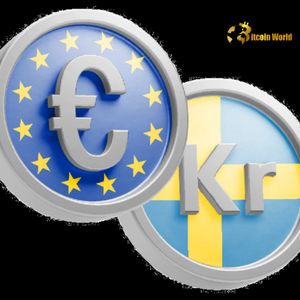EUR/SEK Forecast: UBS Predicts Significant Upside Risks
5 min read
BitcoinWorld EUR/SEK Forecast: UBS Predicts Significant Upside Risks While cryptocurrency markets often grab headlines, understanding broader macroeconomic trends and traditional financial markets, like Forex, provides essential context. Currency movements, particularly for major pairs, reflect shifts in global economic sentiment, central bank policies, and geopolitical events – factors that can indirectly influence the flow of capital into or out of riskier assets like crypto. Today, we delve into a specific view from a major financial institution: UBS’s outlook on the EUR/SEK forecast , highlighting potential upside risks for this specific currency pair analysis . UBS, a global leader in financial services, has recently shared its perspective on the Euro (EUR) versus the Swedish Krona (SEK) exchange rate. Their analysis points towards potential upside movement for the EUR/SEK pair. This means UBS analysts believe the Euro could strengthen relative to the Swedish Krona in the foreseeable future. Understanding the reasons behind such a forecast requires looking at the economic landscapes of the Eurozone and Sweden, as well as broader market dynamics. Why UBS Sees Potential Upside for EUR/SEK A forecast predicting upside risks for a currency pair isn’t made in isolation. It stems from careful consideration of various economic indicators, central bank stances, and market positioning. UBS’s view on the UBS EUR/SEK outlook is likely influenced by several key factors: Monetary Policy Divergence: Differences in how the European Central Bank (ECB) and the Riksbank (Sweden’s central bank) approach interest rates and quantitative easing can significantly impact currency valuations. If UBS anticipates the ECB maintaining a tighter stance relative to the Riksbank, or vice versa in a way that favors the Euro, it could support an upside view for EUR/SEK. Economic Growth Outlooks: The relative health and growth trajectory of the Eurozone economy compared to Sweden’s economy play a crucial role. Stronger growth prospects in the Eurozone could attract investment, increasing demand for the Euro. Inflation Trends: Inflation rates and expectations in both regions influence central bank decisions and purchasing power. Diverging inflation paths can create pressure on the exchange rate. Global Risk Sentiment: The Swedish Krona is sometimes considered more sensitive to global risk appetite than the Euro. In periods of heightened global uncertainty or risk aversion, investors might prefer the relative safety of the Euro, potentially leading to EUR/SEK upside. Conversely, in risk-on environments, the SEK might perform better. UBS’s view on global sentiment would factor into their Forex market outlook . Technical Factors: Chart patterns, support and resistance levels, and trading volumes also inform institutional forecasts. UBS’s analysis would incorporate technical indicators alongside fundamental data. What Does “Upside Risks” Mean for the Currency Pair? When analysts refer to “upside risks” for a currency pair like EUR/SEK, they are suggesting that the probability or potential magnitude of the pair moving higher is greater than it moving lower. It doesn’t necessarily mean they predict a straight line ascent, but rather that the balance of factors leans towards a stronger Euro against the Swedish Krona . This implies that traders and investors should be mindful of potential appreciation in the exchange rate. For instance, if the current EUR/SEK rate is around 11.50, an upside risk forecast suggests that a move towards 11.60, 11.70, or even higher is considered more likely or has a higher potential payoff than a move towards 11.40 or lower, based on UBS’s assessment. These forecasts often come with specific target levels or ranges, though the core message is the directional bias. Actionable Insights from the UBS EUR/SEK View While this is an institutional forecast and not financial advice, understanding the rationale behind it can provide valuable insights for those involved in the Forex market outlook or even those tracking global economic health. Here are some potential takeaways: Monitor Key Data: Keep an eye on economic releases from both the Eurozone (e.g., inflation data, GDP growth, ECB announcements) and Sweden (e.g., inflation, GDP, Riksbank meetings). Surprises in this data can either reinforce or challenge the UBS forecast. Watch Central Bank Commentary: Statements and forward guidance from the ECB and Riksbank are critical. Any shifts in their expected policy paths can quickly alter the attractiveness of their respective currencies. Assess Global Sentiment: Pay attention to broader market sentiment regarding risk. A significant shift towards risk aversion or risk-on trading could impact the SEK’s performance relative to the EUR. Consider Positioning: While not a direct recommendation, understanding that a major bank sees upside risks can inform how traders might approach positioning in the EUR/SEK pair, potentially looking for opportunities consistent with an upward trend, while always managing risk. It’s important to remember that Forex markets are influenced by a multitude of factors, and even well-researched forecasts carry risk. Market conditions can change rapidly based on unforeseen events. Comparing Economic Headwinds: Eurozone vs. Sweden To grasp the potential for divergence driving the currency pair analysis , let’s briefly compare some economic aspects often considered by analysts like those at UBS: Both the Eurozone and Sweden face common global challenges, such as supply chain issues, energy price volatility, and the lingering effects of recent global events. However, their specific vulnerabilities and policy responses can differ. For example, the structure of their economies (e.g., reliance on exports, specific industries) and their sensitivity to interest rate changes can vary. The housing market in Sweden, for instance, has been a point of focus, and its performance can impact the Riksbank’s decisions. In the Eurozone, the diverse economic conditions across member states present a different set of challenges for the ECB. UBS’s forecast likely weighs these specific economic nuances, concluding that the balance of factors currently favors a strengthening Euro relative to the Swedish Krona . Conclusion: Navigating the EUR/SEK Landscape UBS’s view that the EUR/SEK pair faces potential upside risks provides a specific angle on the current Forex market outlook . This perspective is grounded in an analysis of monetary policy, economic fundamentals, and market dynamics in both the Eurozone and Sweden. For anyone tracking currency markets, this serves as a signal to pay close attention to data and central bank actions that could validate or contradict this forecast. While the world of Forex might seem distant from the fast-paced crypto space, understanding these fundamental market analyses helps build a more complete picture of the global financial environment. To learn more about the latest Forex market trends, explore our articles on key developments shaping currency pair analysis and global macro trends. This post EUR/SEK Forecast: UBS Predicts Significant Upside Risks first appeared on BitcoinWorld and is written by Editorial Team

Source: Bitcoin World



